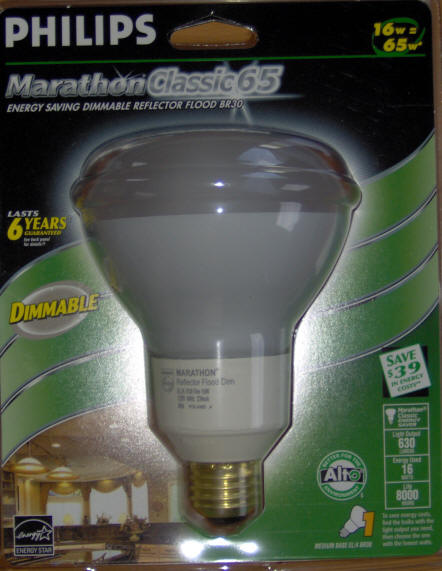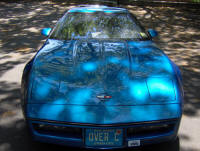RIKLBLOG
|
| Tomorrow |
| 08 Oct. 2008 |
| Yesterday |
| Index |
| Eventide |
| SETI League |
| PriUPS Project |
| Bonus! |
| Contact |


RIKLReviewTM
-
Philips Dimmable Compact Fluorescent
or, to be maximally specific
Philips Marathon Classic 65 Energy Saving Dimmable Reflector Flood BR30
A Fancy Name, an Expensive Light Bulb
I am relamping the house with CFLs. That sentence should surprise nobody, although a few years ago it might have elicited incomprehension. On the tiny chance that it still does, let me 'splain: CFLs, which are "compact fluorescent lamps," replace ordinary incandescent lamps, and offer an enormous energy saving. They are more expensive than ordinary lamps, but they last much longer and use so much less energy that this CFL, which costs $11, should save $39 in energy. But you knew all that. My point in writing this blogitem is not to exhort you to relamp your house. I trust you already have, or have at least started.
That's where I was a few days ago: In the "already started" column. And I was stuck. My house has a large number of recessed fixtures that use reflectorized lamps, typically of the 75 watt persuasion. A large percentage of them have dimmers. On my first pass at the CFL project, Ikea had the twisty lamps meant to replace ordinary bulbs on sale. I think they were only $2.00 each, and I put them in the few places they would be appropriate. Next, and for significantly more money, Home Depot offered reflectorized lamps, and I replaced the incandescents in the small handful of non-dimmable luminaires. But I remained stymied by the dimmable fixtures. The CFLs I tried were fine when the dimmer was fully ON, but either didn't dim or flickered if I tried to modulate their brightness.
NV Philips Gloeilampenfabrieken to the Rescue
Actually it's "Philips Lighting Company." I just like the old name better.
 |
The original incandescent lamp (left) and the replacement CFL The Philips lamp provides illumination equivalent to a 65 Watt incandescent while consuming only 16 Watts of power. Most importantly, it is "dimmable," which means it passes the aesthetic test. Which brings us to the RIKL Review. |
 |
A Short RIKL Review
My housemate (who shops) came home with a couple of these bulbs. I tried them in a dimming fixture and they seemed to be OK. I whined about the price, which was $11, and suggested some comparison shopping. When she went to buy a quantity, the store was nearly out of stock, and she ended up buying what appeared to be a General Electric equivalent product for a bit less money. I was happy with the saving until I tried them and discovered that they didn't seem to have the same dimming range as the Philips. Back to the first store, which now had stock.
I installed five of them in the main entranceway, all controlled by the same dimmer. I was pleased to see that all had the same variable brightness throughout the dimmer's range. Their one flaw (worse with the GE model) is that the range is limited. They go from full-bright to about 1/4-bright by eyeball measurement. The incandescent lamps go all the way from full to nothing. I installed a few more in different locations and made the same observation. I don't view this brightness-range limitation as too serious, since there is little point in turning on a light if you can barely see it. Much more importantly, they all worked with the dimmer and responded to its setting. In other words, they were usable.
There is controversy over how "warm" fluorescent lighting appears. Those more sensitive than I might have a complaint or, conversely, prefer the appearance of the CFL. Although I noticed a change, it's a distinction without a difference for me.
Other considerations? The bulbs fit in the sockets and they all worked. They save energy. They were packaged in those preposterous plastic bubbles that you need power tools to open. I can see doing that for tiny and very expensive consumer items as a shoplifting preventative; doing it with light bulbs is gratuitous. It is too soon (by 5 years, 11 months and 3 weeks) to judge if they will function for the advertised period. If they do, they are likely to be replaced at that time by LED lamps, which promise even greater efficiency and by that time should be reasonably priced.
Unlike complicated consumer products such as the iPod, which I'm still getting used to, there isn't all that much to say about a light bulb. I managed four paragraphs, more than enough. In summary, these are OK and I recommend them. An interesting issue, however, is where to use them. I have always been a "turn out the light when you leave the room" kind of guy. In consequence, many of my incandescent lamps have never failed and probably never will, since they are only used a few hours per year. Should these be replaced with energy-saving lamps? Mathematically, the homeowner would need to know not only the comparative prices of the lamps and energy, but also when he is going to either sell the house or die. Rather than spend a lot of time thinking about either, I simply replace the heavily-used lamps with CFLs and save the still-good replaced lamps for use in rarely-turned-on fixtures.
|
Follow-Up 09 October 2008 |
Reader bbot, who characterizes himself as a "professional light bulb changer for a large office building" kindly offered some thoughts:
...So! To sum up:
lighting by hot wire is bad bad bad. But...
Fluorescents do pretty poorly when subjected to frequent power cycling.
Our vendor of hilariously expensive lighting products refuses to provide
bulb lifetime graphs with cycles below three hours, (as in: three hours
on, fifteen minutes off, three hours on, &c) so is it fair to assume
that bulb lifetime improves so spectacularly that they're afraid we
won't believe them? No, it is because it drops like a brick off the
Empire State Building.
And this is with their gold-plated ultra-expensive electronic ballasts.
It cannot possibly hope to be better with the miniaturized ballasts they
stick in integrated compact fluorescents. My experience with the
CF13FL/BR30 is limited, since we've only got a couple dozen of them
between two tenants; but good, having only seen three lamp failures in
the last three months, with burn cycles of 12 hours on, 12 hours off. It
may last longer in a residential application, it may not.
Another thing to consider: When cold, the bulbs will take a couple of
minutes to reach full brightness, and might refuse to light at all below
50F or so.
In my review, I neglected to mention two well-known characteristics of the CFLs. As bbot says, they take time to reach full brightness, and as he doesn't say, there is also a delay, which I peg as a few hundred milliseconds, between the time you throw the switch and the time they light up.
A Few Words About Words
When I typed the word "luminaire," the Microsoft spell checker rejected it. "Luminaire" is a perfectly standard, dictionary word and is commonly used as a synonym for "lighting fixture." Microsoft has also rejected "incandescents" although it is happy with the singular. It rejected " 'splain," presumably because it never watched I Love Lucy, and is having problems with "relamp" and "reflectorized."
None of which would have elicited any comment, save for the fact that it has no trouble at all with "dimmable," surely not a word in common use. It does not appear in the dictionary, although it does follow the normal rules of English construction.
When I typed "gloeilampenfabrieken" a hand came out of the screen and grabbed my throat.
| Special Advertising Section | ||
 |
Please buy this lovely blue
Corvette ZR1!
(The Mitsubishi has been sold, and the buyer (from South Dakota!) has it safely home.) |
|
NP: "Wild Heart" - Stevie Nicks
| © 2008 |
| Richard Factor |